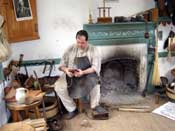Williamsburg Travel Review

Williamsburg History
In May, 1776, Virginia's Colonial representatives meeting in Williamsburg (the capital of Virginia and seat of its government) passed resolutions for independence from Great Britain, a month after the British Royal Governor Dunmore seized the gunpowder magazine and Colonial weaponry. A few months later, the Declaration of Independence would be debated, ratified, signed and read aloud to Colonists in the new nation. The Revolutionary War raged for almost eight years. In September 1781, General George Washington addressed his troops gathered in Williamsburg before the historic battle at Yorktown, Virginia where Washington defeated Cornwallis to bring an end to the conflict. Many of the principles and rights we accept and live by today were first seriously debated and codified in the Virginia Declaration of Rights. These principles would influence the drive for liberty throughout Europe, being copied in part within the French Declaration of the Rights of Man and the Citizen.Although once the seat of Virginia's government (the capital was moved to Richmond to reduce the risk of invasion by water) and a bustling point of commerce, Williamsburg's downtown became neglected (and almost forgotten) until the early 1900s. Dr. W.A.R. Goodwin, the rector of the Bruton Parish Church, began the first restoration within the city when he began work on the Colonial-era church in 1905. In 1926, oil tycoon John D. Rockefeller visited the city and decided to join the restoration efforts. In the 1930s, the restoration work throughout Williamsburg had succeeded in transforming the city into its former grandeur; President Franklin Roosevelt praised the work in 1936. The now restored Duke of Gloucester Street, along with the Governor's Palace, the Capitol Building, Raleigh Tavern and many other buildings stand proudly along what Roosevelt called "the most historic avenue in America". More Williamsburg History...
Williamsburg Restaurants
Williamsburg Attractions
There are daily reenactments throughout Williamsburg whether a public reading from the Capital or Patrick Henry speaking on Colonial rights behind the Governor's Palace. Be sure to pick up a Williamsburg schedule which highlights the location and time of the various historical activities throughout the day and night.
Other places to visit nearby for true history buffs are Yorktown (where the famous battle ending the Revolutionary War was fought) and Jamestown (site of the first permanent English settlement on the American continent in 1607). The area is abuzz due to the recent 400th anniversary of the Jamestown settlement; you can see this in Virginia's license plates now. Much of the region is also Civil War country, so those interested in history should find the entire area fascinating. Enjoy your steps back in time visiting the Williamsburg area...don a three-cornered hat, have a pint of ale at the King's Arms Tavern... breathe some 18th century air...and take a carriage ride to soak in the grandeur of the period. More Williamsburg Attractions...
